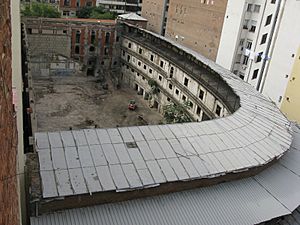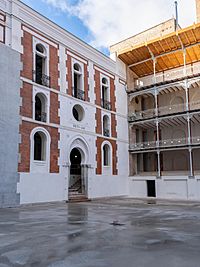Beti Jai fronton facts for kids
Quick facts for kids Beti Jai fronton |
|
|---|---|
 |
|
| Location | Madrid, Spain |
| Official name: Frontón Beti Jai | |
| Type | Non-movable |
| Criteria | Monument |
| Designated | 27 January 2011 |
| Lua error in Module:Location_map at line 420: attempt to index field 'wikibase' (a nil value). | |
The Beti Jai fronton is a special sports building in Madrid, Spain. It's like a big court where people used to play a game called Basque pelota.
This amazing building is located at 7 Marqués de Riscal Street. It was built in 1893 and opened its doors in 1894. The last game of Basque pelota was played here in 1919. After that, the building was used for many different things.
The Beti Jai fronton is the only one of its kind from the 1800s left in Madrid. Because it's so important, it was declared a special historical monument on January 27, 2011. The building was fully fixed up and restored in 2019, making it look great again!
Contents
A Look Back: The History of Beti Jai
Building the fronton started in 1893. It cost about 500,000 Spanish pesetas, which was a lot of money back then! A famous architect named Joaquín Rucoba designed it. He also designed other important buildings in Spain.
In the late 1800s, Basque pelota was super popular in Madrid. The Beti Jai was one of four big frontons built in the city around that time. It opened on April 29, 1894, and was a busy sports venue until 1919.
After its time as a sports court, the building had many different lives. From 1904 to 1906, a smart inventor named Leonardo Torres Quevedo used it to work on his automatic machines. During a big war in Spain, the building became a police station. Later, it was a place for music bands linked to a political group to practice. In the middle of the 1900s, a car company called Citroën bought it and used it as a repair shop.
In 1997, a company from the Basque Country bought the fronton for 2.3 million euros. They hoped to bring sports back to the building. Another company, Aguirene, later took over the property.
On January 27, 2011, the Beti Jai fronton was officially named a "Bien de Interés Cultural." This means it's a very important cultural site that needs to be protected.
The City Council of Madrid started a process to buy the building back in 2010. They finished buying it in 2015 for 7 million euros. After that, a huge restoration project began, and the building was completely fixed up by 2019.
What Beti Jai Looks Like
The Beti Jai Fronton is on Marqués de Riscal Street, close to a main road called Paseo de la Castellana. It's in a part of Madrid called Chamberí. The whole area it covers is about 3,609 square meters, and the building itself is huge, with 10,800 square meters of space!
The building has different styles mixed together. The front of the building has an "Eclectic" style, which means it combines ideas from different periods. Inside, you can see "Neo-Mudéjar" designs, which use patterns and shapes from old Spanish-Islamic art. It also has "Cast-iron architecture," which was popular in the 1800s and uses strong metal frames.
At the heart of the fronton is a large outdoor playing field. It's 67 meters long, 20 meters wide, and 11 meters high. Around this field are the stands where people would sit to watch the games. These stands curve around the eastern and southern sides of the court, shaped like half of an oval.
The grandstand can hold up to 4,000 people! It has four floors, with balconies and railings made of wood. The stands are held up by a strong network of iron columns and beams. Some of these beams are curved to make the stands slope upwards. There are even old paintings called frescoes on the ceilings!
On the western side of the court, there's a curved wall with those special Neo-Mudéjar designs.
Other Beti Jai Frontons
Did you know there were other frontons also called Beti Jai? There were ones in Barcelona, San Sebastián, and Logroño. The one in San Sebastián later became a theater but was destroyed in a fire in 1913.
See also
 In Spanish: Frontón Beti Jai para niños
In Spanish: Frontón Beti Jai para niños




